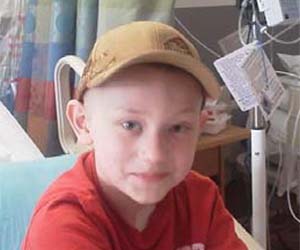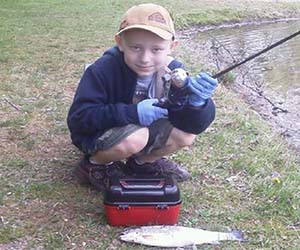 Matthew is our middle child and only boy. We welcomed him into our arms on a warm Wednesday afternoon on April 30, 2003. He’s your “typical” boy: loves to be outside, fishing, hunting, riding his ATV, playing baseball, football and golf. I’ve lost count on the number of Monster Truck rallies he’s been to with his father. His other love is coin collecting, I’m not certain where that love came from, but I can tell you I’m learning a lot about coins – more than I think I want to know.
Matthew is our middle child and only boy. We welcomed him into our arms on a warm Wednesday afternoon on April 30, 2003. He’s your “typical” boy: loves to be outside, fishing, hunting, riding his ATV, playing baseball, football and golf. I’ve lost count on the number of Monster Truck rallies he’s been to with his father. His other love is coin collecting, I’m not certain where that love came from, but I can tell you I’m learning a lot about coins – more than I think I want to know.
Up until January of this year, he was a healthy and happy child. He was attending school, fighting/playing with his sisters, hanging with his friends – like most 8 year olds – without a care in the world.
Then one early Sunday afternoon in January when Matthew sat in front of me on the living room floor, my husband pointed out a small lump on the right side of Matthew’s neck. After asking Matthew a number of questions I made an appointment with the pediatrician for later that day. The pediatrician noted swelling in several lymph nodes in his neck, but nowhere else. He drew blood to check his CBC and for mono. The following day we learned that the blood results were normal and the mono was negative.
On Thursday we returned to the pediatrician for a follow-up. He immediately noticed that the swelling had increased and he no longer felt individual swollen lymph nodes, but one larger mass. He wanted to get the opinions of several specialists to see the best way to proceed.On Monday we arrived at St. Peter’s University Hospital for a consultation with a pediatric oncologist-hematologist. To determine what the mass on his neck was, he was admitted to the Hospital following his consultation.
The following two days were filled with x-rays, CAT Scans, biopsies, blood draws and many more invasive and non-invasive tests.
 Ten days from the date when my husband and I first noticed the lump on my son’s neck, we were advised by the Hospital that he had T-Cell Acute Lymphoblastic Leukemia (“T-ALL”). The mass on his neck that started at the size of marble was now larger than a softball. We were advised that it was even larger on the inside of his body and was very close to compromising his windpipe. Immediate medical care was started to shrink the mass. During the 12 days he spent in the hospital he also had his portacath (for receiving chemotherapy intravenously) put in and began his regime of chemotherapy.
Ten days from the date when my husband and I first noticed the lump on my son’s neck, we were advised by the Hospital that he had T-Cell Acute Lymphoblastic Leukemia (“T-ALL”). The mass on his neck that started at the size of marble was now larger than a softball. We were advised that it was even larger on the inside of his body and was very close to compromising his windpipe. Immediate medical care was started to shrink the mass. During the 12 days he spent in the hospital he also had his portacath (for receiving chemotherapy intravenously) put in and began his regime of chemotherapy.
In the blink of an eye, our world as we knew it was about to change. Matthew would no longer be a “typical” boy and his father and I would no longer be only his parents. Our parenting roles expanded to include caregiver, nurse, medical terminology expert, and pharmacist among other titles. Life as we knew it, including our daughters, would be defined differently. We are learning to take each day as it comes, appreciate the small stuff and not sweat over minor things. It has taught us a whole new appreciation towards life and each other.
Fortunately, ALL is curable. Matthew was diagnosed with T-Cell ALL, of which less than 10% of children diagnosed with ALL suffer from. It is a type of leukemia that has a high tendency to work its way through the spinal fluid and up into the brain. The protocol is 4+ years of consistent chemotherapy, bone marrow biopsies and spinal taps to get into remission, prevent the cancer from entering the spinal fluid and keep the “monster” at bay. Ten years following the end of treatment, if the bone marrow continues to come back clean, Matthew will be considered cured.
“It takes a village to raise a child” (African proverb) cannot be a more accurate saying as we guide ourselves along this frightful journey. With the support and love from teachers, friends, family and our community we are confident that Matthew will destroy his “monster” and continue to develop into the young man he is meant to be.
